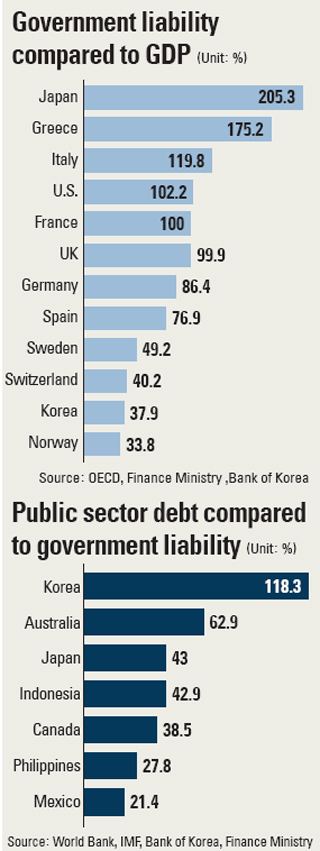Debt is burying state-run companies

The private think tank released a report yesterday saying that snowballing loans at state-run companies are higher than those of 13 other countries surveyed.
As of 2011, Korean government debt alone was 468.6 trillion won ($422.6 billion), or 37.9 percent of gross domestic product. This is much lower than Japan (205.3 percent), Greece (175.2 percent), Italy (119.8 percent) or the United States (102.2 percent). The average debt-to-GDP ratio of Organization for Economic Cooperation and Development member countries is 102.9 percent. Other countries with similar-sized economies to Korea are Sweden (49.2 percent), Switzerland (40.2 percent) and Norway (33.8 percent).
“Considering the size of Korea’s economy, the government’s debt burden isn’t big,” said Cho Young-moo, a senior economist at LG institute.
“However, when comparing the debt ratio of state-run companies to the government’s overall debt to those of other countries, there are concerns,” Cho added.
The ratio of Korean state-run companies’ debt to government is 118.3 percent, nearly double that of second-ranked Australia (62.9 percent). Japan is third at 43 percent.
Even when excluding currency stabilization bonds issued by the Bank of Korea, state-run institutions’ debt was 80.7 percent of GDP.
“The government’s debt usually passes through numerous processes, including budget deliberation and approval by the National Assembly,” Cho said. “But in the case of state-run companies, these processes are weaker.”
The report also raised concerns about the rate at which these debts are increasing compared to the expansion of assets. The 295 public companies’ assets grew by 144.4 trillion won in the past three years, but they added 156.6 trillion won in debt to a total of 493.4 trillion won.
The report noted cited the four-rivers project pushed by the Lee Myung-bak administration and the long-term lease apartment projects known as “Bogeumjari” as significant reasons for the increasing debt. Investment in energy-related sectors as well as a reluctance to raise fees were other major contributors.
Debt owed by energy companies is at an especially critical level.
According to the Ministry of Trade, Industry and Energy, as of 2012, Korea Electric Power Corporation’s (Kepco)debt ratio stood at 186.2 percent, while Korea Gas Corporation’s (Kogas) was 385.4 percent.
The Land and Housing Corporation had the largest debt ratio at 466 percent.
The state-run housing company also had the largest debt by size at 138 trillion won, ahead of Kepco (95 trillion won) and Kogas (32 trillion won).
Kepco, which had been suffering from growing debt every year, last year confronted the Lee administration by demanding a 10 percent rate increase.
The proposal was shot down numerously as the Lee administration was focused on easing the financial burden that may come from higher public utility cost.
With the combined debts of the government and public firms edging close to 1,000 trillion won, there have been rising concerns that these liabilities will not only burden the government, but likely dent the economic growth.
“Setting a right fiscal policy starts with an exact assessment of fiscal soundness,” said the LG institute researcher.
By Lee Ho-jeong [ojlee82@joongang.co.kr]










with the Korea JoongAng Daily
To write comments, please log in to one of the accounts.
Standards Board Policy (0/250자)